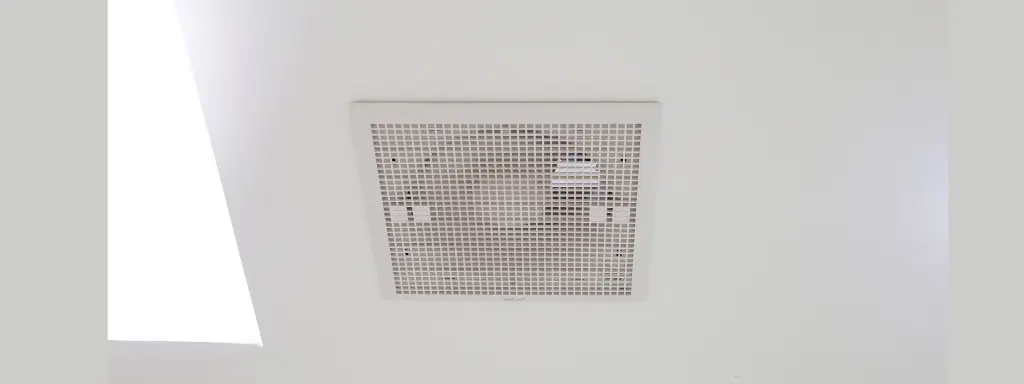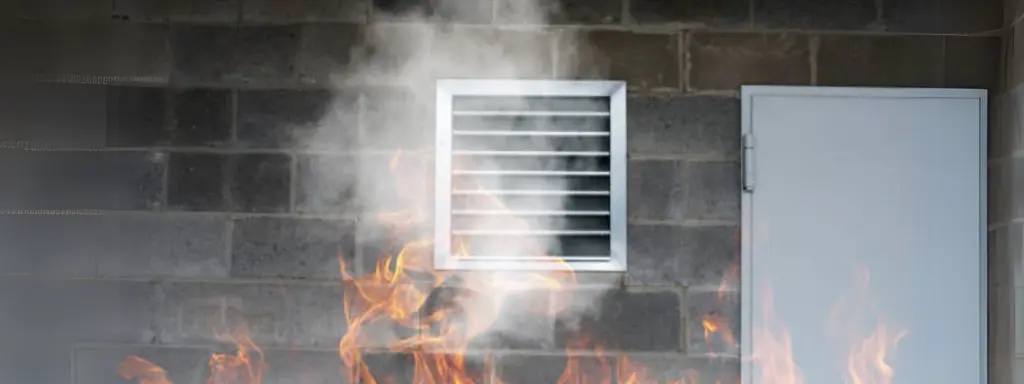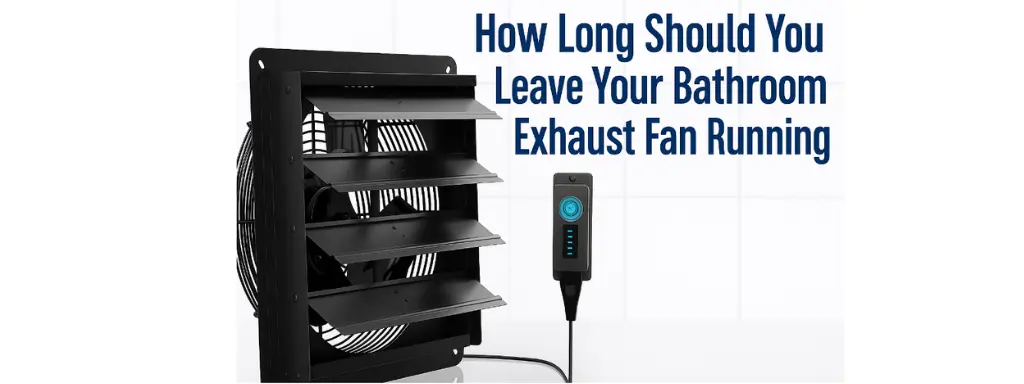Did you know bathrooms are a major source of unhealthy indoor air? They fill with moisture and mold in no time without proper ventilation, creating health hazards. How long should you leave your bathroom exhaust fan running becomes a big question for a healthy home.
Bathroom exhaust fans are part of a home’s ventilation system. They let fresh air in and out of excess moisture and particles that can cause health problems. While many run their fans for 10-20 minutes after showering, experts recommend leaving them on for at least 30-54 minutes to get rid of excess moisture. Too short and you risk mold and mildew. Too long and you’re wasting energy.
This article answers that question and also shows you how to choose the right fan, like the 576 CFM Shutter Exhaust Fan, for your space. Whether you’re a homeowner, contractor or commercial operator, this article is your complete solution to moisture control and optimal ventilation.
Why Bathroom Exhaust Fans Are Important?
Bathroom exhaust fans are the first line of defense against moisture problems in one of the wettest areas of your home. The importance of these devices go beyond just clearing foggy mirrors after a hot shower.
Removes moisture and prevents mold
Bathrooms experience huge humidity spikes during showers and baths, creating perfect conditions for mold growth. Mold can start growing in 24-48 hours in moist environments; that’s why proper ventilation is crucial. Without enough exhaust, warm, humid air condenses on surfaces and seeps into walls, causing speckling on ceilings and walls.
Mold exposure is a serious health risk, especially for those with allergies or asthma. 96% of chronic sinus infections are caused by mold exposure and removing mold from homes can reduce asthma symptoms.
Improves indoor air quality
Beyond moisture control, bathroom exhaust fans improve indoor air quality. They extract airborne bacteria, odors and pollutants that spread throughout your living space. This ventilation balances humidity levels and maintains proper air circulation.
During showering, contaminants become airborne and can migrate to other parts of your home. A functioning exhaust system contains these particles and expels them outside, creating a healthier environment for everyone in the household.
Protects walls, tiles and fixtures
Excessive moisture can damage bathrooms over time. Without proper ventilation, long term exposure to humidity can cause peeling paint and wallpaper, cracked or warped walls, Rusted fixtures and cabinets, warped doors and damaged wood elements.
These are not just cosmetic issues; if left unchecked, they can lead to costly structural repairs. Proper ventilation protects your bathroom’s integrity and your investment and prevents extensive damage that would require professional remediation services.
The right size of your bathroom exhaust fan matters. Experts recommend 1 CFM (cubic feet per minute) per square foot of bathroom area for most bathrooms. This ensures the fan can remove moisture before it causes damage or creates health hazards.
How Long Should You Leave Your Bathroom Exhaust Fan Running

Proper timing is crucial when running your bathroom exhaust fan to remove moisture and prevent damage to your bathroom. Knowing the right runtime helps maintain a healthy home and extends the life of your fan.
Standard recommended duration after showering
Experts differ slightly on the ideal runtime for bathroom exhaust fans. The general recommendation is to run your fan for 10-20 minutes after showering or bathing. This duration usually allows enough time for humidity levels to decrease and moisture to be removed from the bathroom surfaces.
But some professionals suggest longer runtime. The Building America Solution Center recommends leaving the fan on for a full hour after showering for better humidity control. This extended operation ensures complete moisture removal especially in bathrooms with poor natural ventilation.
Factors that affect runtime (room size, humidity)
Several variables affect how long your bathroom fan should run:
Bathroom size: Larger bathrooms have more air volume, requiring longer ventilation time. For example, a 10’ × 15’ bathroom with 10’ ceiling would need a 200 CFM rated vent fan to exchange air properly.
Shower duration and temperature: Longer, hotter showers generate more steam and moisture, requiring longer fan operation.
Fan capacity: A bathroom ventilation system should deliver eight full air changes per hour. Undersized fans require longer runtime to achieve the same effect.
Local climate: Humid environments may require longer fan operation than dry climates.
How Long to Run a Bathroom Exhaust Fan
Residential Bathrooms
As a general guideline, keep the fan running for 15 to 20 minutes after you finish showering or bathing. This duration ensures all humid air is removed and indoor air quality is maintained.
Running the fan too long may waste energy especially if you’re not using an energy efficient model. But modern models like AitecAC’s energy optimized units are designed for high airflow and low power consumption, so that concern is minimized.
Commercial & Industrial Bathrooms
Ventilation needs increase in commercial or high traffic areas like office buildings or shopping malls. In these cases, consider running the fan on a timer switch or continuous mode especially during peak hours.
A model like the 576 CFM Shutter Exhaust Fan is perfect for such applications. With high airflow and automatic shutters, it’s designed for large scale ventilation and long term durability.
What Happens If You Run It Too Long?

While bathroom exhaust fans provide ventilation, running them too long has several risks to be aware of. Knowing these dangers helps homeowners make informed decisions about fan operation.
1) Overheating and fire hazards
Bathroom exhaust fans left running for extended periods pose a serious fire risk. These fans are not built for continuous operation. Over time, dust and lint accumulate inside the fan housing creating an easily ignitable fuel source that can catch fire when the motor overheats.
Most concerning is that bathroom fans are often left unattended during extended operation. When overheated, a fan motor can reach temperatures over 340°F, exceeding the standard insulation rating of 266°F. This extreme heat can cause the wire insulation to fail, potentially igniting nearby combustible materials and spreading to structural elements in your ceiling.
2) Motor wear and energy waste
Running the fan too long accelerates motor wear. Most bathroom exhaust fans operate at around 2,000 RPMs and this continuous high speed rotation eventually leads to premature failure.
Continuous operation also wastes a lot of energy. Even small fans consume electricity constantly, resulting in higher utility bills. For context, a single furnace fan running 18 extra hours a day can add between $157 to $630 a year to your electricity bill depending on its wattage. Plus, excess ventilation wastes both electricity and the energy needed to heat replacement air.
3) Carbon monoxide risks
The most overlooked danger is carbon monoxide (CO). In some cases, exhaust fans can create negative pressure in your home and draw CO back down the flues from gas appliances. This “backdraft” effect happens when exhaust ventilation exceeds air replacement through infiltration.
Carbon monoxide is dangerous because it’s odorless, colorless and toxic. Over 400 to 500 people die annually from CO poisoning. The symptoms often mimic common ailments like the flu or allergies making detection difficult without proper CO alarms.
Tip: Run your bathroom fan for 15-20 minutes after use then turn it off especially before leaving home.
How do you determine the correct fan size and runtime?
Correct fan sizing is crucial. CFM, or cubic feet per minute, is the standard unit used to measure recommended airflow. Here’s how to calculate what you need:
Residential Calculation:
For bathrooms up to 100 sq. ft., use 1 CFM per sq. ft.
For bathrooms exceeding 100 sq. ft., include extra airflow by adding 50 CFM for each fixture such as a shower, toilet, or tub.
Commercial Calculation:
For larger spaces like commercial restrooms or industrial locker rooms, start with a base of 50 CFM per 100 sq. ft. and increase based on occupancy.
Once you’ve determined the right size, make sure to choose a fan that matches that capacity. For high demand applications, AitecAC’s 10-inch 576 CFM fan is a great choice, providing efficient high volume ventilation for larger spaces.
Timer, Humidity Sensor or Manual Switch?
There are three main control methods to run your bathroom exhaust fan:
1. Manual Switch
Most common but least efficient. It requires users to remember to turn it off after use.
2. Timer Switch
Recommended for homeowners. You can set it for 15-30 minutes to ensure moisture removal without running it endlessly.
3. Humidity Sensor
The most advanced and energy efficient option. These fans automatically turn on when humidity levels rise and shut off when the room is dry.
AitecAC fans can be integrated with smart controls and timers making them suitable for both residential and commercial applications.
Common problems from inadequate bathroom ventilation
If you don’t run your bathroom fan long enough the consequences may be more than aesthetic:
- Mold Growth: High humidity creates a breeding ground for mold.
- Paint & Wallpaper Peeling: Excess moisture damages finishes.
- Structural Damage: Over time, moist air may lead to wood rot or ceiling damage.
- Health Concerns: Poor air circulation encourages allergens and respiratory issues.
AitecAC’s shutter exhaust fans ensure airflow in demanding environments, a big plus for commercial contractors and facilities managers.
What Makes Aitecac Fans Stand Out?
Choosing the right fan is just as important as how long you run it. AitecAC’s industrial ventilation solutions are designed for:
- High CFM Ratings: Like the 10-inch 576 CFM fan, perfect for large spaces.
- Commercial Grade Durability: Anti-rust aluminum shutters and weather-resistant construction.
- Energy Efficiency: Optimized for airflow without high energy bills.
- Easy Installation: Wall-mountable, compact designs fit tight spaces.
Whether you’re ventilating a commercial building, workshop, warehouse or greenhouse, Aitecac’s shutter exhaust fans are the most reliable and powerful.
Installation Best Practices
Even the best fan can fail if installed incorrectly. Follow these guidelines:
- Install Near the Source of Humidity: Typically above the shower or bathtub.
- Use Proper Ducting: Short, straight, and well-insulated ducts reduce backdrafts.
- Include a Backdraft Damper: Stops outside air from entering.
- Seal All Joints: Avoid air leaks to maintain suction power.
AitecAC’s fans come with detailed installation guides and expert support to ensure your setup performs at its best from day one.
When to Replace Your Bathroom Exhaust Fan
Over time, fans lose their efficiency. Consider replacing your fan if:
- It makes excessive noise.
- Moisture lingers long after showers.
- Mold or odor becomes persistent.
- It’s over 10 years old.
Upgrading to a high-powered solution like the AitecAC Airbird T10 model ensures peace of mind and energy savings in the long run.
Conclusion: Solve Moisture Issues Before They Start
So, how long should you leave your bathroom exhaust fan running? The short answer is 15-30 minutes for homes and continuously or on timers for commercial spaces. Beyond just runtime, the quality of your fan plays a major role in its effectiveness. Choosing the right fan is equally essential.
Investing in a high-efficiency model like Aitecac’s Bathroom Exhaust Fan or the powerful 576 CFM Shutter Exhaust Fan ensures faster, quieter, and more efficient ventilation. These products aren’t just fans. They are solutions designed to solve real ventilation challenges.





